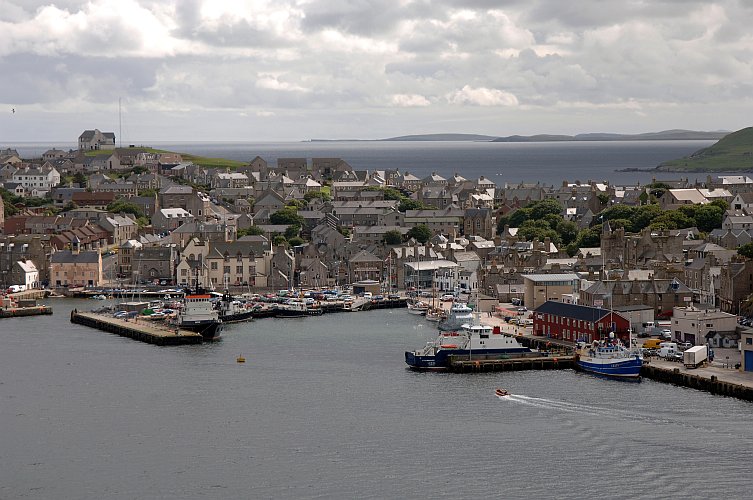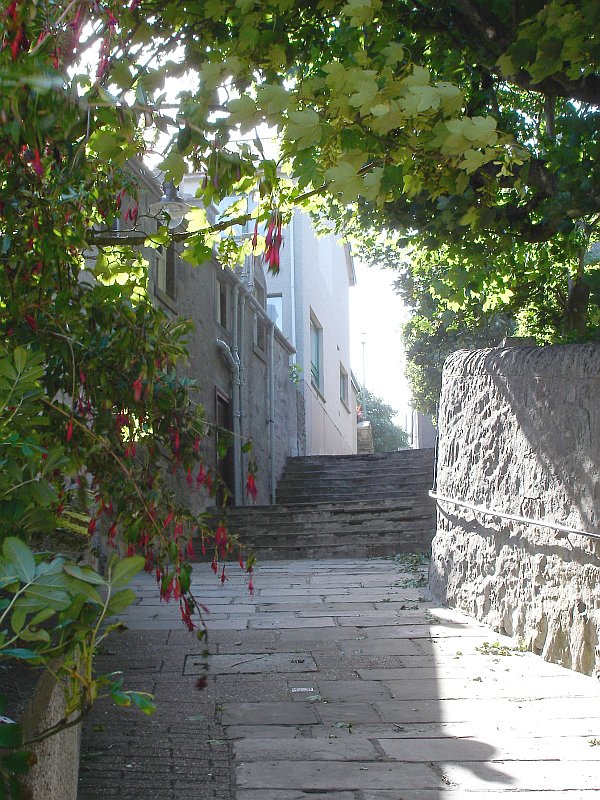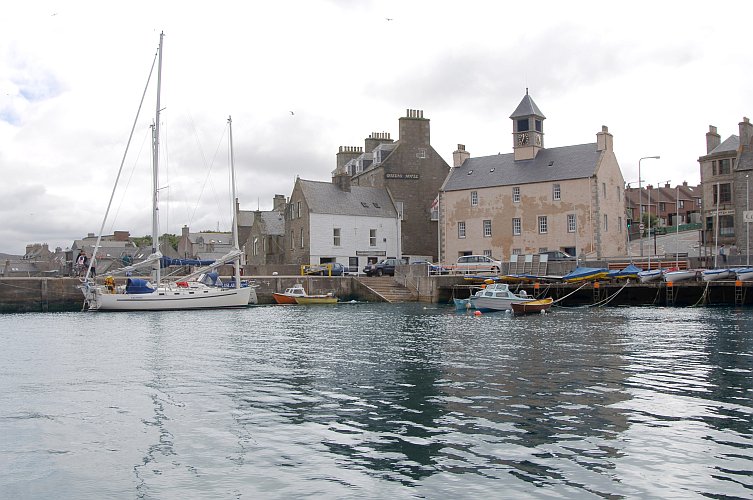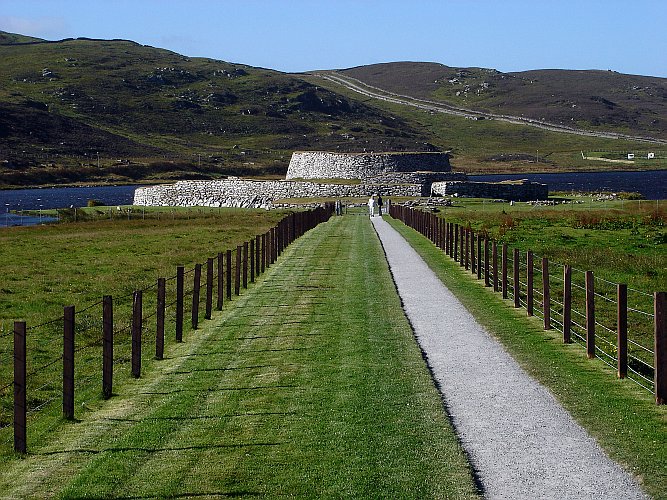Welcome to Lerwick
Lerwick, Shetland’s capital, takes its name from the Old Norse Leirvík meaning muddy bay. Sheltered by Bressay, the natural harbour attracts a wide range of visiting craft. The town has a lot to offer visitors and will introduce you to Shetland’s unique identity.
 Lerwick Town Centre
Lerwick Town Centre
 Lerwick became important relatively late in Shetland’s history, building on the trade from the Dutch herring industry, only becoming capital in the 17th century.
Lerwick became important relatively late in Shetland’s history, building on the trade from the Dutch herring industry, only becoming capital in the 17th century.
From the scattering of huts and winding shoreline track, which became Commercial Street, development was tightly packed into a patchwork of narrow lanes. In the 19th century, new docks to accommodate the fishing fleet were created to the north of the town.
At Freefield, Hay’s Dock was the centre of Shetland’s fishing industry and the largest ship built in Lerwick, the barque North Briton, took to the water here in 1836. The dock is now home to the Shetland Museum and Archives.
By the late 19th century, the more prosperous citizens were moving from the old part of town to flatter land west of the Hillhead and the town has continued to expand to become a thriving and welcoming place of around 7,600 people serving all the 23,000 inhabitants of Shetland. There is a wide range of accommodation, a choice of eateries, pubs and clubs. Lerwick is also an excellent place to sample Shetland’s internationally-celebrated musical heritage. The islands are best known for their traditional music, but there’s a wealth of talent embracing a wide range of styles.
Commercial Street and the Lanes
 A Lane in Lerwick
A Lane in Lerwick
 Stone-flagged Commercial Street, the heart of the town, is the first port of call for most visitors. Winding between tall stone buildings it gives a unique character to one of the finest small town centres in Britain and the hub of much of Shetland’s social and business life. Above Commercial Street, The Lanes have been rescued from earlier dereliction and sheltered, wooded private gardens are bright with fuchsia and flowering currant. As today’s street signs acknowledge, the Lanes were originally Lons and Klosses, but were renamed by the Commissioners of Police in 1845 to reflect personalities or themes of that time, hence Pitt, Reform and Fox Lanes.
Stone-flagged Commercial Street, the heart of the town, is the first port of call for most visitors. Winding between tall stone buildings it gives a unique character to one of the finest small town centres in Britain and the hub of much of Shetland’s social and business life. Above Commercial Street, The Lanes have been rescued from earlier dereliction and sheltered, wooded private gardens are bright with fuchsia and flowering currant. As today’s street signs acknowledge, the Lanes were originally Lons and Klosses, but were renamed by the Commissioners of Police in 1845 to reflect personalities or themes of that time, hence Pitt, Reform and Fox Lanes.
The Small Boat Harbour and Tolbooth
There’s always something of interest in this small dock to the south of Victoria Pier. It is the home of Lerwick’s lifeboat, a 1997 Severn Class vessel whose coxswain and crew have been decorated for several extraordinary rescue operations.
The Swan, a restored Fifie herring drifter built in Lerwick in 1900, can often be seen here, though from May to September she’s heavily used for sail training and cruises around the islands and further afield. The Dim Riv, an imaginative reconstruction of an old Norse galley, does trips around the harbour during the summer.
Just above the small boat harbour, the old Tolbooth dating from 1770 originally housed the Sheriff Court and the prison, though it later saw service as a Customs House, a Post Office, Fishermen’s Mission and a Red Cross centre.
Lodberries
 Lerwick Harbour
Lerwick Harbour
 The word lodberry comes from the Old Norse hlaðberg, meaning a place where boats could be brought alongside for loading or unloading. The simplest lodberry was a suitable flat rock, but the surviving examples below the south end of Commercial Street consist of a jetty with a store and house. Before they were built, all goods were moved by small boat to and from the ships at anchor offshore and many merchants had their own lodberry. Shetland – and especially Lerwick – had a reputation as a hotbed of smuggling. In recent times an assortment of barrels, kegs and jars has come to light in cellars and tunnels under the street.
The word lodberry comes from the Old Norse hlaðberg, meaning a place where boats could be brought alongside for loading or unloading. The simplest lodberry was a suitable flat rock, but the surviving examples below the south end of Commercial Street consist of a jetty with a store and house. Before they were built, all goods were moved by small boat to and from the ships at anchor offshore and many merchants had their own lodberry. Shetland – and especially Lerwick – had a reputation as a hotbed of smuggling. In recent times an assortment of barrels, kegs and jars has come to light in cellars and tunnels under the street.
Fort Charlotte
The northern end of Commercial Street passes below what were once sea-cliffs, surmounted by the towering walls of Fort Charlotte, from which there are excellent views.
Built in 1665-7 by Charles II’s master mason John Mylne, its pentagonal form was intended to house a garrison, defend the landward area and deny the use of Bressay Sound to any enemy. However, it was burned by the Dutch in 1673 and lay ruined until 1782 when the barrack blocks seen today were built. Named after King George III’s Queen, it is the most complete surviving example of its type.
The Town Hall and the County Buildings
A little way south-west of the Fort is Lerwick’s Town Hall, a beautifully-preserved building with Scots Baronial and Gothic influences designed by Alexander Ross and completed in 1883 by local builder John M. Aitken, at a cost of £3,240. Armorial work recalls many of the town’s cultural and trading links. Rich stained glass – best seen in late afternoon or evening sunlight – depicts characters from Shetland’s history. A guidebook is available.
Across the road from the Town Hall, prominent crow-stepped gables lend the more restrained County Buildings a particularly Scottish flavour. They house the sheriff court, police station and cells.
Shetland Library
Shetland Library is situated in the former St. Ringan’s Church at Lower Hillhead. The Shetland Room reflects the proliferation of writing about Shetland. The library is open 9.30 am - 5 pm, Monday to Saturday, with late opening until 8 pm on Monday and Thursday.
If you are tracing your Shetland ancestors, why not visit the Shetland Family History Society at 6 Hillhead, across the road from the library. They are open for research daily from 2 - 4 pm and some evenings.
At King Harald Street you will find the King George VI parks - comprising a well equipped play park and adjacent flower park with a tennis court and bowling green.
The Legacy of Arthur Anderson
Arthur Anderson was born in 1792 in the Böd of Gremista, now a museum celebrating his life. As a youth, he helped with the curing and drying of fish and in 1808 joined the Royal Navy. He later joined a London partnership running ships to Spain and Portugal which was to become the Peninsular and Oriental Steam Navigation Company (P&O). A philanthropist, Anderson provided funds for the establishment of the Anderson Institute (now Anderson High School). Its motto – “dö weel and persevere” – was the advice given to Arthur Anderson by his employer as he set off to join the Navy. He also built the Anderson Homes, intended originally for the widows of seamen, and for five years was Member of Parliament for Orkney and Shetland.
Shetland Museum and Archives
The Shetland Museum and Archives is located in the historic Hay’s Dock. This new facility is an invaluable resource for both visitors and locals, introducing Shetland’s story and provide a gateway to other local sites of interest. The two main museum galleries house over 3000 artefacts and introduces Shetland’s story through 12 thematic zones.
The archives hold the written record of Shetland’s past dating back to the 15th century. There is also a large oral history collection, musical archives and microfilm copies of local newspapers, parochial records and census records. All these can be viewed in the searchroom.
The building also includes a café restaurant serving local produce; a shop selling local crafts and gifts; a temporary exhibition space for local, national and international exhibits; a wide range of specially commissioned artwork throughout the building and environs; and a 120 seat auditorium. It is open daily and entry is free.
The Knab to Ness of Sound
A path follows the cliff top from Twageos Road to Breiwick Road, providing an easy walk past the cemetery and around the Knab, where you can enjoy a game of golf or get a good vantage point of Bressay Sound. Wave-washed slabs of gently sloping sandstone provide haul out points for the many Common Seals that can be seen basking around the Knab and at the Sletts.
More energetic walkers can continue around Breiwick and down to the Ness of Sound, passing Pullers Loch, a good spot to see ducks such as Mallard, Goldeneye, Pochard and Merganser and perhaps even catch a glimpse of an Otter. Alternatively, take the pathway around the west side of the Clickimin Loch to the summit of Staney Hill, from where the setting of Lerwick and its harbour can be properly appreciated.
Clickimin
 Clickimin Broch
Clickimin Broch
 Lerwick’s largest open public space is around the Clickimin Loch. The Clickimin Centre has superb sports facilities, an excellent leisure pool and a well-equipped camping and caravan site. The loch is notable for its waterfowl. Mallard and Teal can be seen all year round; Goldeneye, Wigeon, Pochard, Tufted Duck and Whooper Swans use the loch as a migration stopover.
Lerwick’s largest open public space is around the Clickimin Loch. The Clickimin Centre has superb sports facilities, an excellent leisure pool and a well-equipped camping and caravan site. The loch is notable for its waterfowl. Mallard and Teal can be seen all year round; Goldeneye, Wigeon, Pochard, Tufted Duck and Whooper Swans use the loch as a migration stopover.
At the southern end of the loch is Clickimin Broch, one of Shetland’s major archaeological sites. It seems that the earliest structure, a Bronze Age house, was built on this small holm in the loch around 600BC.
In the Iron Age, further houses, a defensive ring wall, an impressive block house and the Broch tower, perhaps 12-15m high, were constructed. Later, wheelhouses were added. A guide booklet is available from VisitShetland.
Up-Helly-Aa
On the last Tuesday in January, nearly 1000 torch-bearing guizers march behind a Viking galley, which is burnt with great ceremony as the prelude to a long night of revelry. The Up-Helly-Aa exhibition in the St. Sunniva Street Galley Shed, open during the summer months, catches the mood with displays of Up-Helly-Aa memorabilia, photographs and videos.
Some Useful Information
| Shops: | Commercial Street, Commercial Road, Toll Clock Shopping Centre |
| Post Offices: | 46 Commercial Street, Toll Clock Shopping Centre |
| Library: | Lower Hillhead, Tel: 01595 693868 |
| Museum and Archives: | Hay’s Dock, Tel: 01595 695057 |
| Leisure Centre: | Clickimin Leisure Complex, Lochside, Tel: 01595 741000 |
| Health Centre: | Lerwick Health Centre, South Road, Tel: 01595 693201 |
| Hospital: | Gilbert Bain Hospital, South Road, Tel: 01595 743000 |
| Police Station: | County Buildings, Tel: 01595 692110 |


